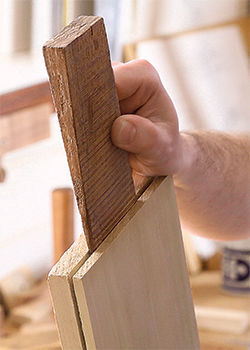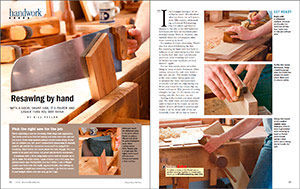Resawing by Hand
With a good, sharp saw, resawing by hand is faster and easier than you may think.

Synopsis: Colonial Williamsburg master woodworker Bill Pavlak demonstrates the art of resawing by hand, showing that you don’t need a bandsaw to create a beautiful book-matched pair of boards or even your own veneer. From scribing a line to advancing the sawcut down the length of the board using a triangle system, follow Pavlak’s step-by-step instructions and you will be resawing by hand in no time.
“I can’t imagine having to do all of that by hand.” Woodworkers often say this to me as I demonstrate 18th-century cabinetmaking at Colonial Williamsburg. I try not only to get them to imagine it, but also to see that hand-tool techniques still have an important place in today’s shops. There is, however, one method where the conversation often stops: resawing by hand.
For starters, it looks exhausting. There’s also fear around following the line. But resawing by hand isn’t that hard or arduous; it just takes trying it a few times to realize that. And once you become proficient, your resawing will never be limited by your bandsaw—or lack thereof—again.

For the best results, there are a few things to keep in mind. Foremost, when sawing, advance the saw only down a line you can see. This means starting at the near corner, taking great care to advance the blade simultaneously across the end and the edge facing you. When you reach the far corner, flip the board and repeat. This process of cutting triangles means you are sawing only the lines you can see.
Starting is the hardest and most crucial part. The wide blade will feel unwieldy until it’s buried in the board, so use the thumb of your off hand to position and steady it on the waste side of the cut. Generally, I saw off my line to leave a little room for error and a little extra thickness that can be planed away later. After a few strokes, the once-wobbly blade will be your best friend as its width helps guide the cut.
Buyer’s Guide: Antique Handsaws
Antique tool dealer Josh Clark shows you
what to look for when buying old, rusty handsaws
Don’t race with the saw and don’t force it. A proper resawing job shouldn’t wear you out. Use the full length of the blade with purposeful strokes, but don’t white-knuckle the handle or bear down on it or the saw plate. Follow the old cliché: Let the saw do the work. Fall into a rhythm and let up a little on the return (pull) stroke.
If the saw begins to drift off course, don’t twist it in the cut to bring it back on track. This will only work on the edge; the saw will still be off course in the middle of the board. Instead, use the set to your advantage by simply pressing the side of the saw. If your saw keeps wandering off course, it’s probably not you. Blame the tool. It needs to be sharpened or reset.
If all goes well, the triangular cuts will meet beautifully. Sometime during the last stroke all the resistance below the blade disappears and “thwump,” you’re through. That moment almost always comes as a sweet little surprise. For those other times, don’t worry. If the kerfs don’t meet but are past where they should have met, pull the boards apart and plane away the wood that remains. It doesn’t feel good when that happens, but you’ll still have a usable piece and it will be better the next time around.
Video: Resawing the Williamsburg Way
When resawing by hand, Colonial Williamsburg’s Bill Pavlak
typically goes it alone. But for wide stock, he choose to
enlist some Hay Shop help.

Resawing by hand works just as well for veneer, and the technique’s the same—albeit much more deliberate and cautious. I won’t saw thinner than a heavy 1/16 in. One of my coworkers has successfully gone down to 1/32 in., but it wasn’t really worth the trouble.
In all honesty, it’s easier to resaw than to write or read about it. I’d dare you to try it for yourself if you don’t believe me, but there’s nothing daring about it. After a little, you’ll turn yourself into the highest-capacity bandsaw in the neighborhood.

From Fine Woodworking #275
To view the entire article, please click the View PDF button below.
Fine Woodworking Recommended Products

Lie-Nielsen No. 102 Low Angle Block Plane

Olfa Knife

Veritas Wheel Marking Gauge








Log in or create an account to post a comment.
Sign up Log in